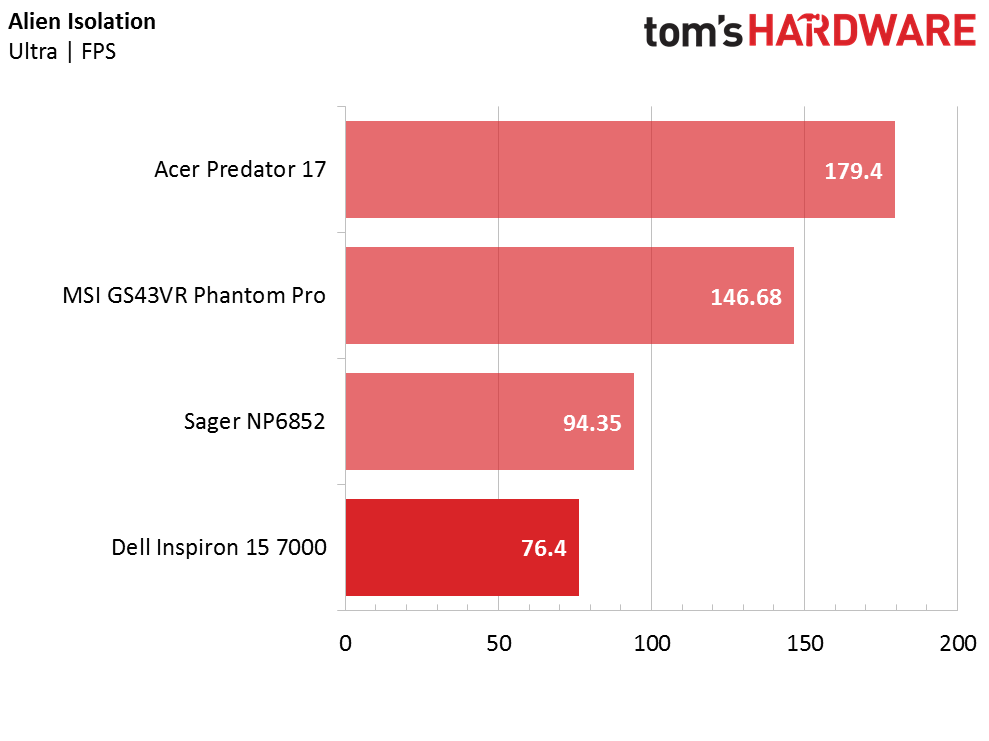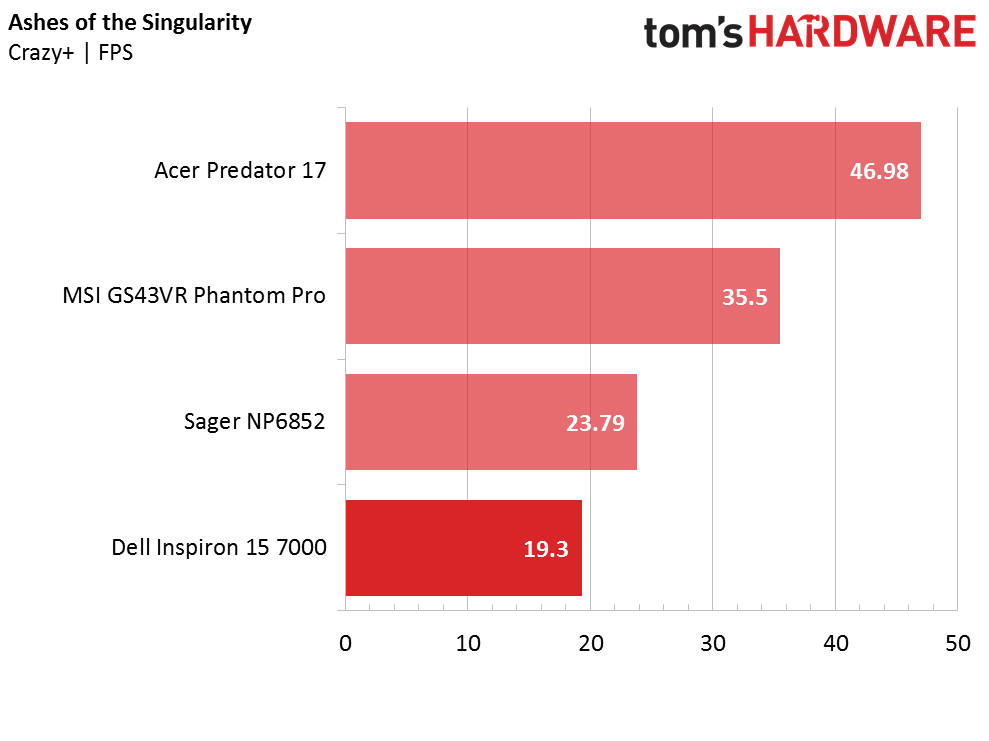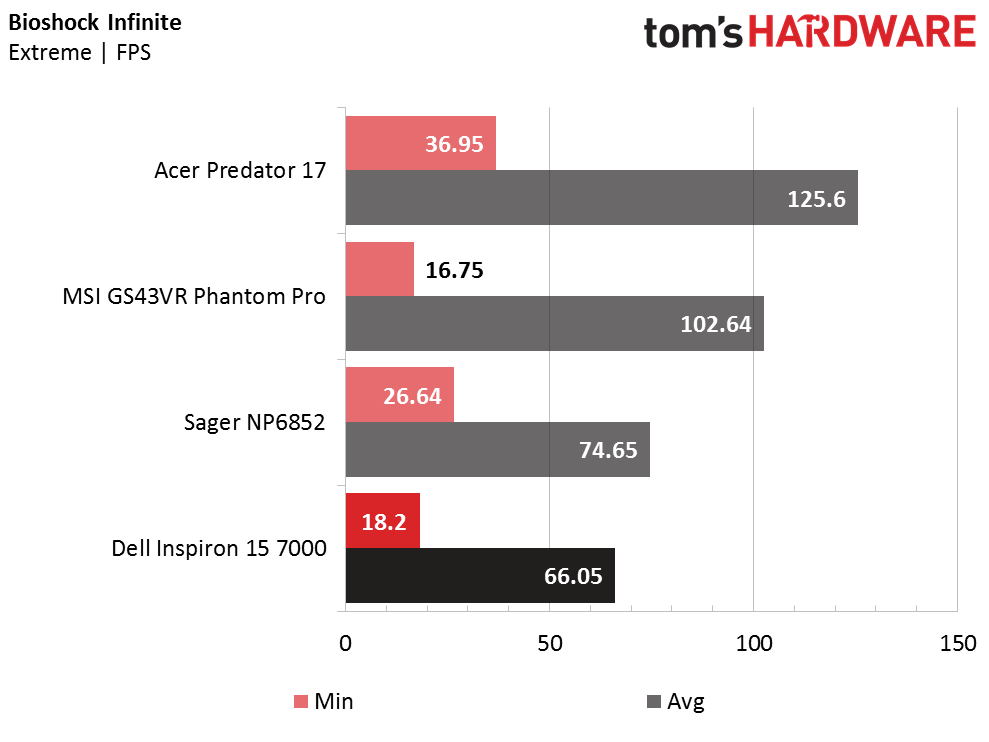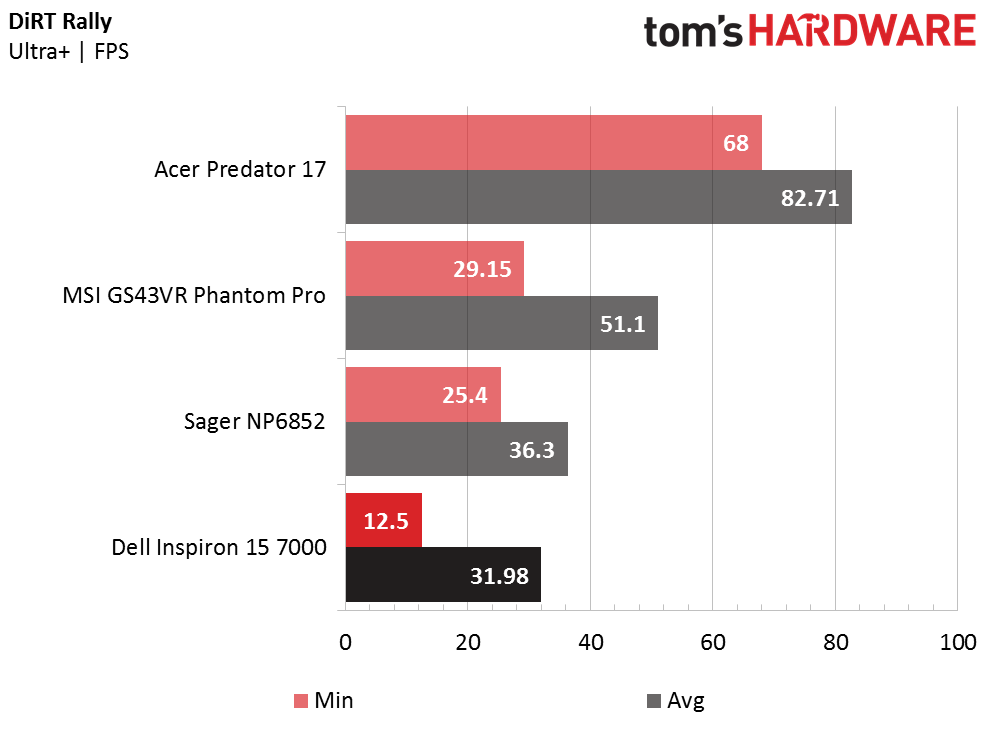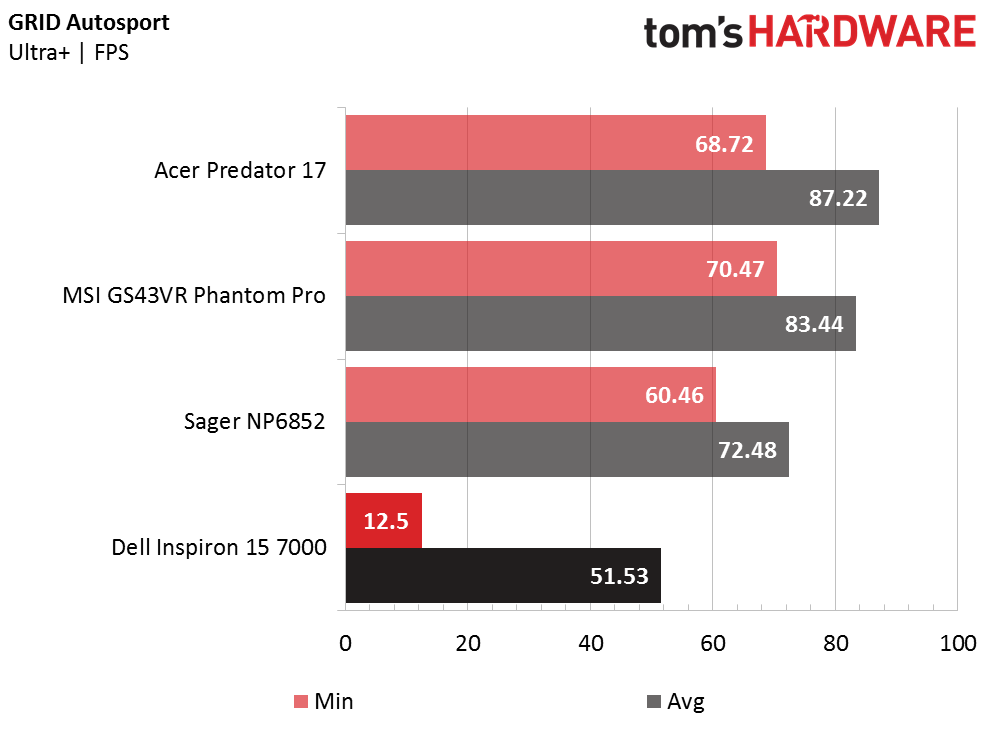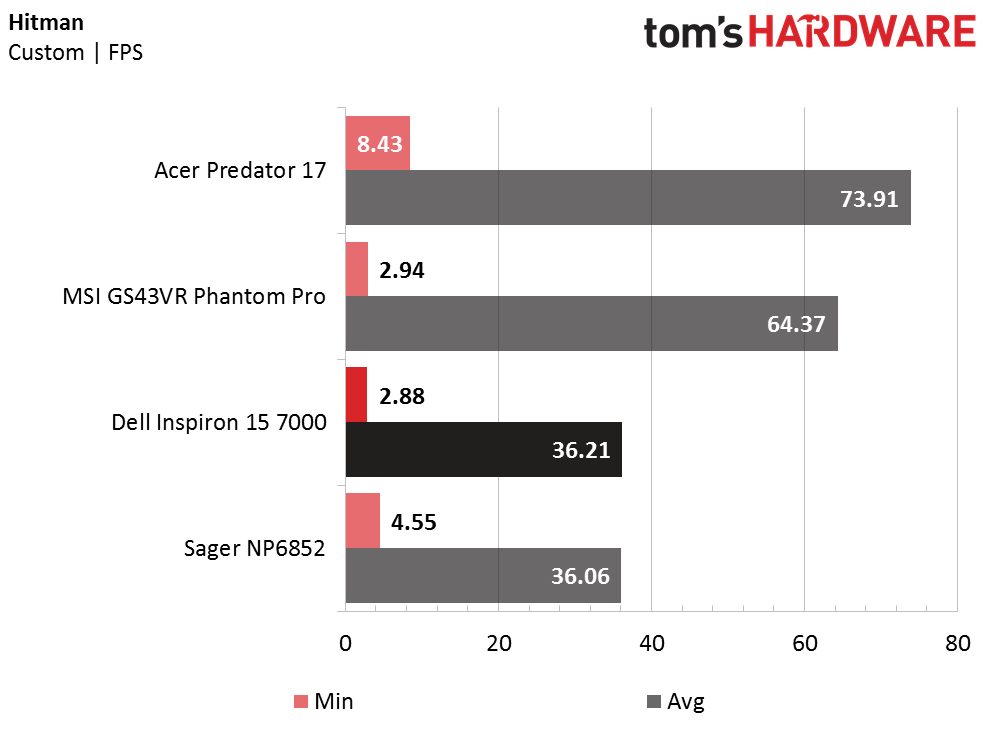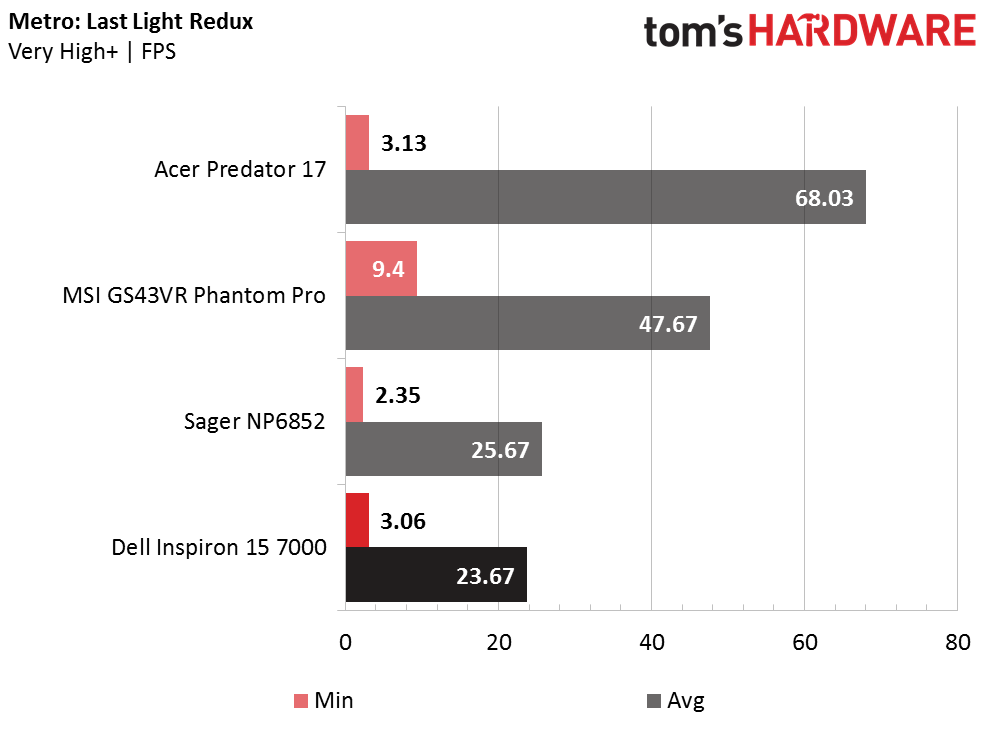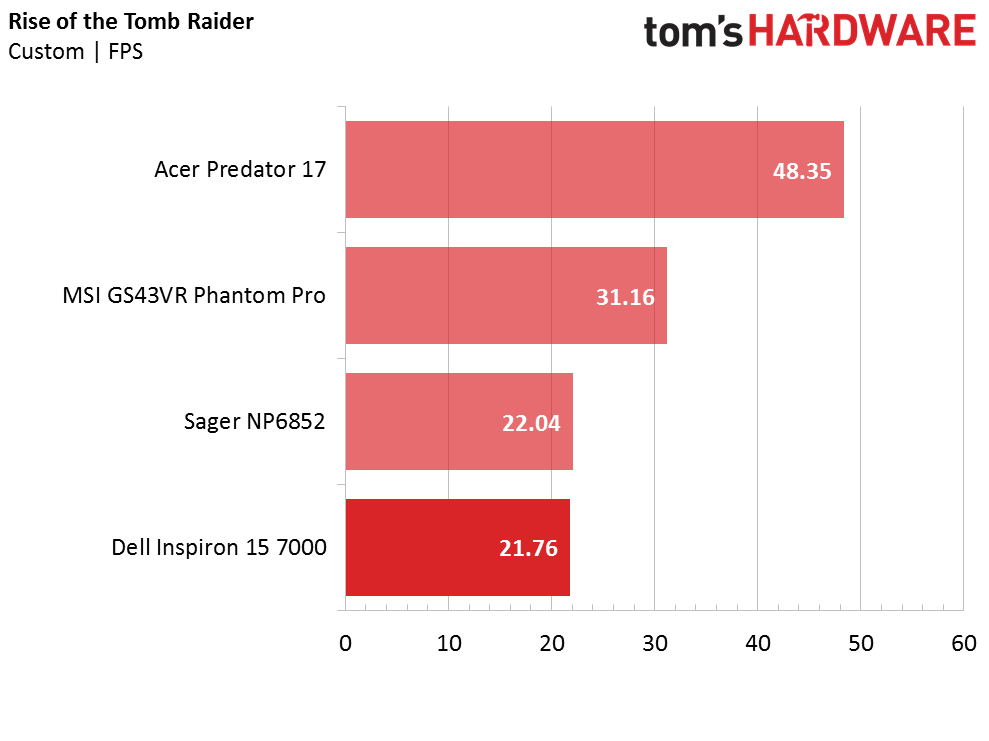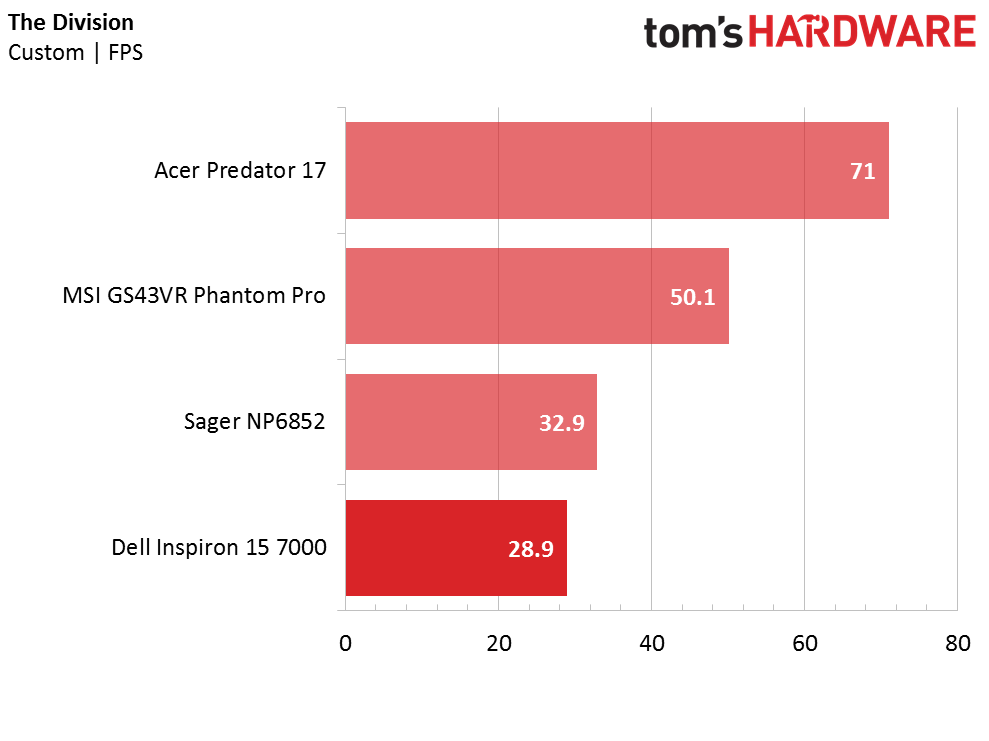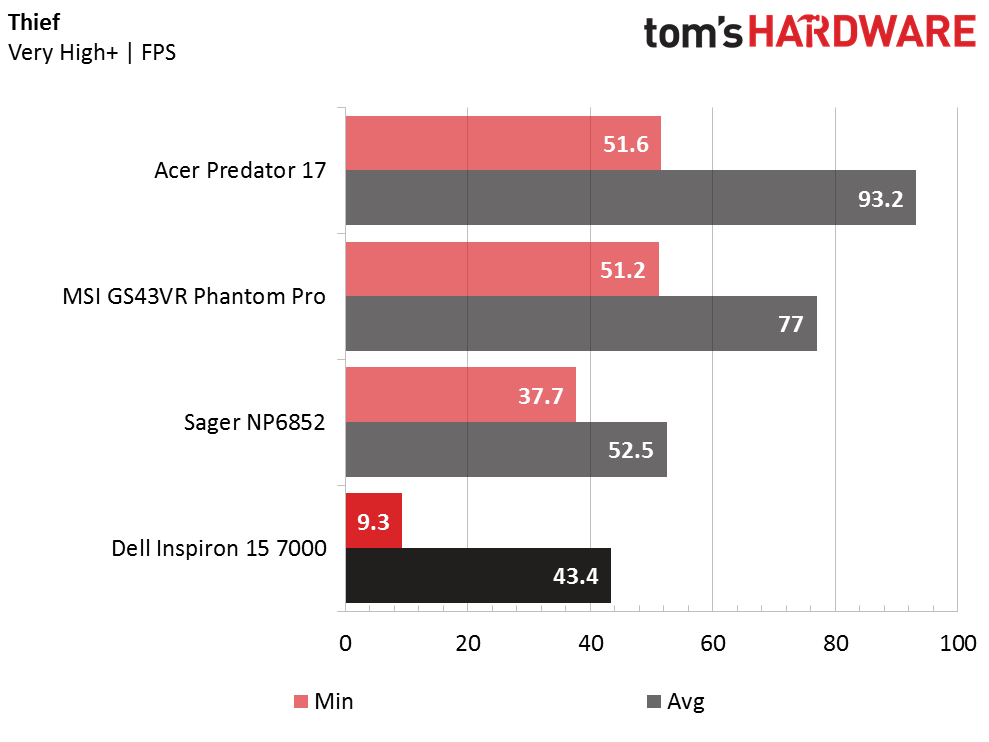Dell Inspiron 15 7000 Gaming Laptop Review
Why you can trust Tom's Hardware
Gaming Benchmarks
Our gaming benchmarks have served to differentiate one system from another, and to illustrate the benefits of various extra muscle in GPU and CPU horsepower, as well as more memory. As we dip into a lower-end configuration like that of the Dell Inspiron, playing AAA titles at max settings may seem a bit unfair. The Dell gaming laptop falls just where you think it will among the comparison set, and it tackles a few of the less taxing games with aplomb. As always, in most games, you can dial settings back to get smoother game play. We'll test other lower end systems over time to see how this gaming laptop fares against equally equipped competitors.
Alien: Isolation
Alien Isolation’s comparatively light benchmark suits the Dell Inspiron 15 7000. The i5-7300HQ and GTX 1050 Ti are more than capable of 60 FPS, even maximum settings. An incremental upgrade to an i7-7700HQ would grant about 23% more performance here, as witnessed with the Sager NP6852. However, an i7-7700HQ and GTX 1060 configuration such as the MSI Phantom Pro easily delivers close to twice the performance.
Ashes of the Singularity
Frames are hard to come by in Ashes of the Singularity. GTX 1060 configurations hover near 30 FPS. The Inspiron 15 scores well beneath a playable framerate. To play anywhere near 60 FPS with high settings, you’ll need more horsepower than even the Acer Predator 17 can handle, and a wallet to match. If 30 FPS is your goal, the MSI Phantom Pro is another $600 away. Turning back the settings will have to suffice.
Bioshock Infinite
Luckily, the Inspiron 15 feels right at home in Bioshock Infinite. The i5 and GTX 1050 Ti combo will suffice for a smooth, 60+ FPS experience, even with the settings cranked up. Upgrading to an i7 won’t net you much more performance, so if you don’t plan on playing anything more demanding than Bioshock Infinite, then Dell’s offering is adequate for the price.
DiRT Rally
With DiRT Rally’s settings cranked to max, the Dell Inspiron is just barely capable of playable frame rates. The Sager laptop performs about 13% better thanks to its i7 processor, but both of these systems will need to have the quality settings lowered if you want to play anywhere near 60 FPS. The MSI Phantom Pro performs much closer to the 60 FPS threshold and can reach it without sizeable compromises in game quality.
Grand Theft Auto V
Grand Theft Auto V’s performance is more GPU bound, so the Inspiron 15 manages to trade blows with the NP6852. However, both of these systems score below 30 FPS in almost all of the benchmark scenes; you’ll need a laptop with at least a GTX 1060 if you want to play with the highest settings at 30 FPS. Jumping up to 60 FPS while retaining some level of visual fidelity would require an investment in a GTX 1070-based laptop.
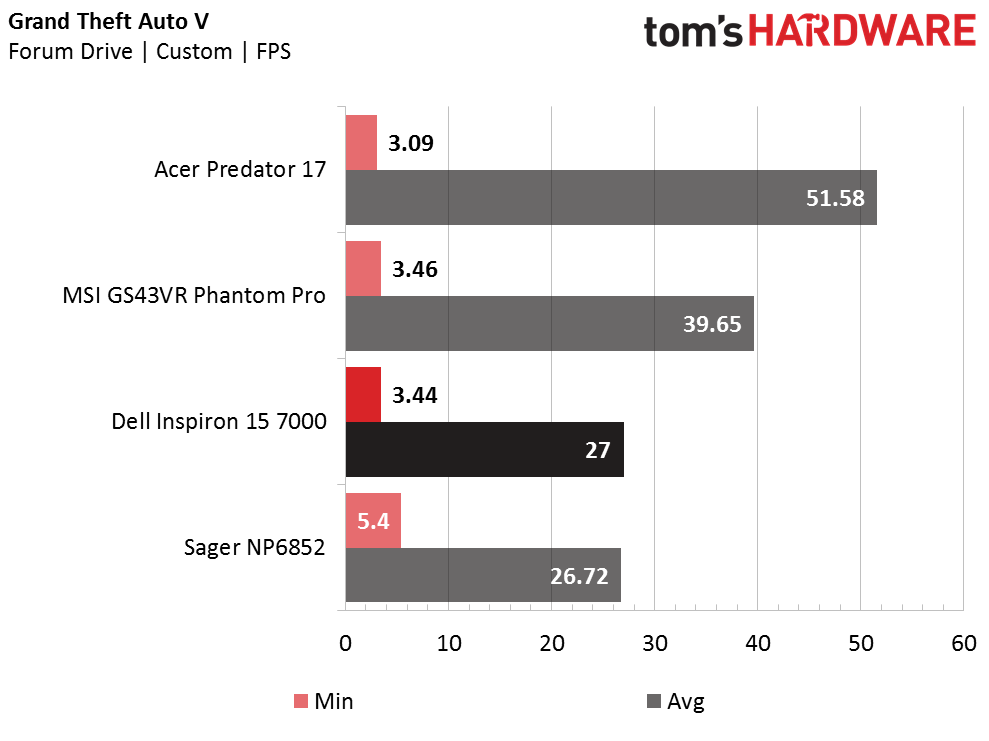
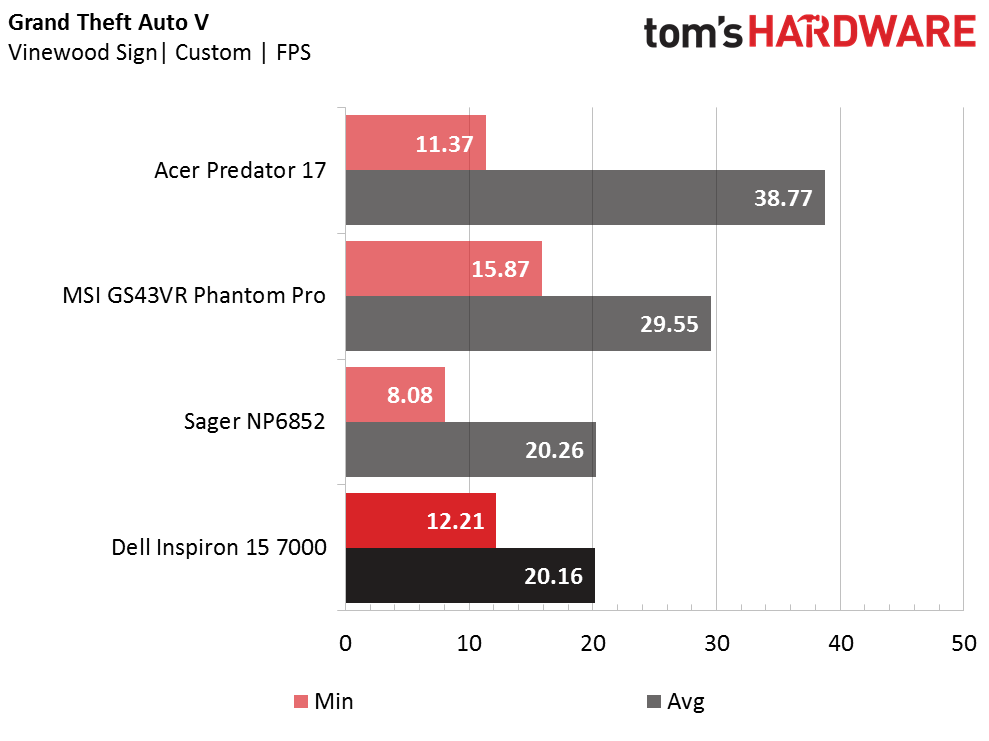
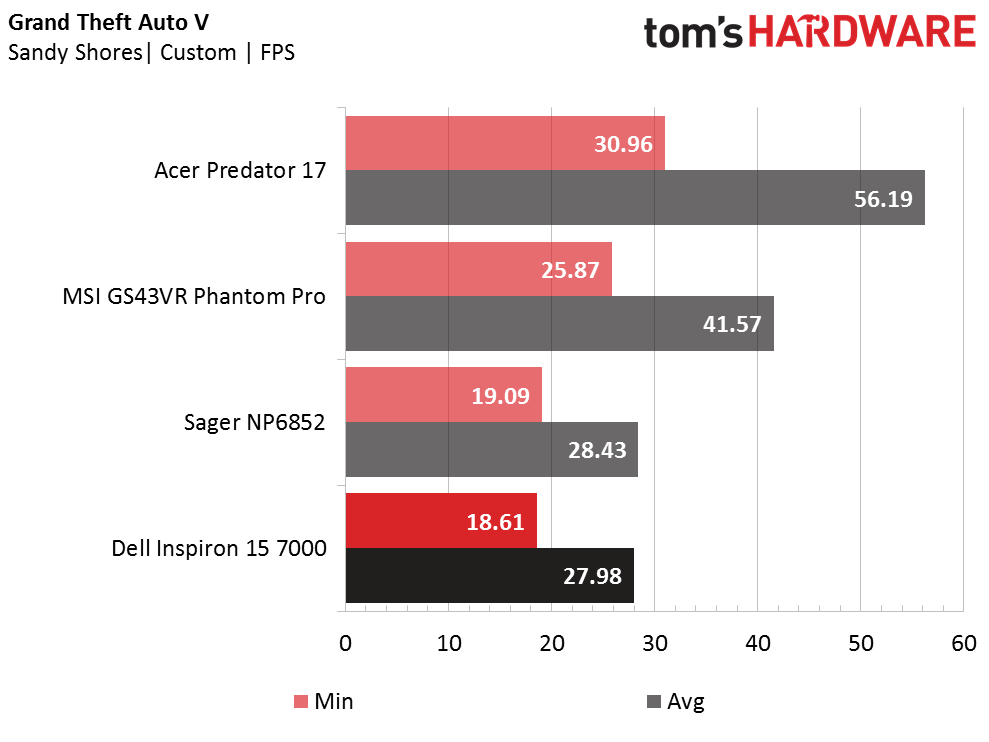
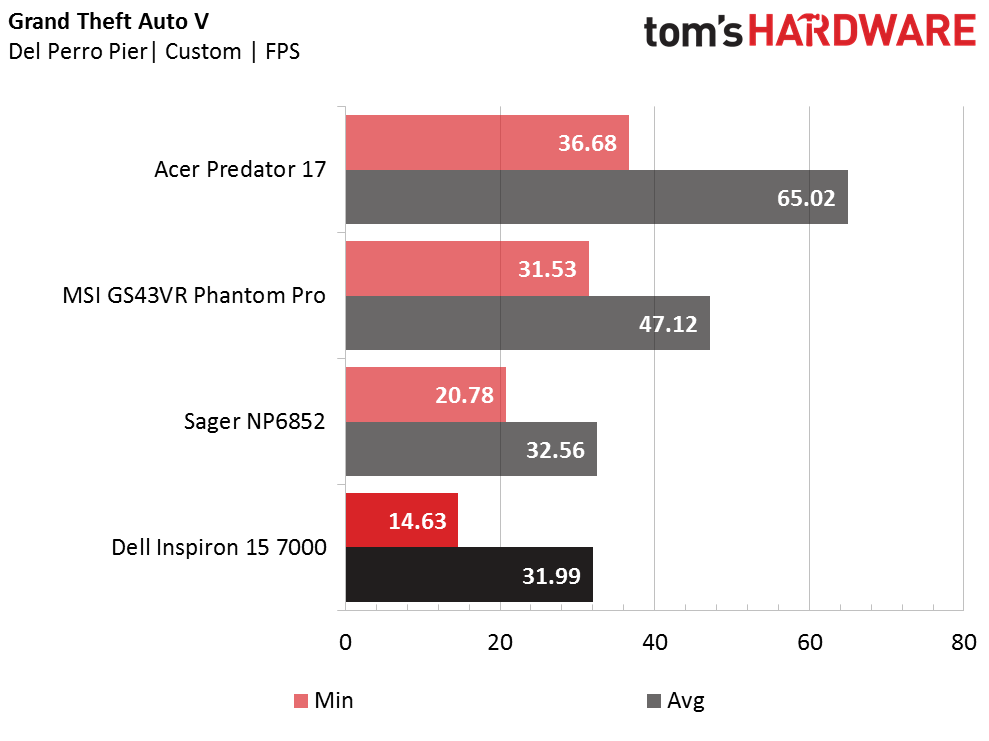
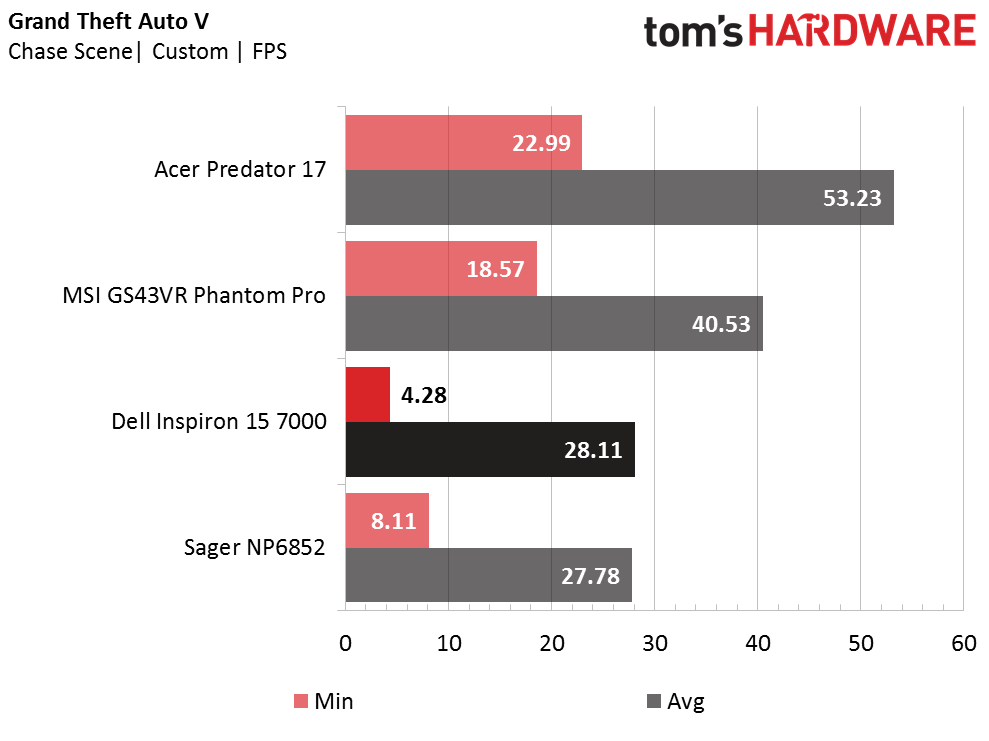
GRID Autosport
GRID Autosport favors a solid all-around platform, although we’ve found that it gives an edge to systems with higher GPU frequency. However, this doesn’t benefit the GTX 1050 Ti, which has a base clock of 1290 MHz. Unfortunately, the Inspiron 15 doesn’t quite make the 60 FPS cut; your configuration would need at least an i7 processor, as evidenced by the Sager laptop’s performance. In fact, upgrading from an i5-7300HQ to an i7-7700HQ would increase your performance by more 40%, resulting in frame rates well above 60 FPS.
Get Tom's Hardware's best news and in-depth reviews, straight to your inbox.
Hitman
Hitman proves to be a heavily GPU-dependent title, so upgrading from a system with an i5 to an i7 would provide virtually no benefit. Unfortunately, this leaves the Dell and Sager laptops barely above playable frame rates. However, the performance increase from a GTX 1050 Ti to a GTX 1060 is massive; The MSI Phantom Pro delivers about 75% more performance, pushing its frame rate well above 60 FPS.
Metro: Last Light Redux
Metro: Last Light’s benchmark was once capable of bringing even the mightiest systems to their knees, but Pascal-equipped laptops with at least a GTX 1060 can enjoy either a respectable frame rate at maximum settings or 60 FPS with a few dials turned back. Sadly, this isn’t the case for GTX 1050 Ti systems. We found frame rate averages dipping into unplayable territory, so you’ll need to pull back your settings quite a bit if you want to play closer to the Phantom Pro’s averages.
Rise of the Tomb Raider
Like Metro: Last Light, Rise of the Tomb Raider is an incredibly demanding benchmark, and perhaps the most taxing one in our suite besides Ashes of the Singularity. Both our Inspiron 15 and the Sager hover around 20 FPS on average, while the Phantom Pro, which performs about 40% better, just barely delivers 30 FPS. Even the Predator 17 cannot survive Rise of the Tomb Raider’s punishment, which prompts a more powerful systems such as the MSI GT73VR Titan Pro.
The Division
The Division’s workload is similar to Rise of the Tomb Raider, although it's not quite as intense. The Dell laptop’s configuration delivers just under 30 FPS, whereas our Sager system performs a few frames higher thanks to its i7-7700HQ. The MSI gaming laptop scores much closer to 60 FPS, however, meaning drastic quality reductions won’t be necessary to enjoy smooth frame rates.
Thief
Finally, Thief greets the Inspiron 15 with a manageable workload. The platform-based title is balanced, so a stronger processor will have a more pronounced effect on performance. As a result the Inspiron 15 performs about 21% slower than the i7-7700HQ-based Sager NP6852.
Current page: Gaming Benchmarks
Prev Page Synthetic Benchmarks Next Page Battery, Thermal, And Display Testing-
blackmagnum I'm sure the Dell will lead the budget gaming laptop price\performance table with its pairing of mobile i5 and 1050Ti.Reply -
cknobman It is not a "gaming" laptop if it cannot play games at a decent framerate.Reply
More Dell marketing gimmicks.
This is a consumer grade laptop that is capable of playing "some" games. -
palladin9479 Pretty good device considering the cost. Sub $1000 USD is a range that's hard to pull real "gaming" off at 1080p, too many cost related constraints. $1200~1500 and higher is where you can fit in the more expensive dGPU's required to do high FPS gaming. So considering that, Dell has done a very good job of providing a "good enough" device for people on a budget.Reply -
ScrewySqrl looks like it would be more than capable at medium settings rather than high/ultra.Reply
and if the $900 is too expenasive, they offer it for $799 with a 1 TB 5400 HDD and a base 1050. again, a medium settings gamer, or older systems, which is pretty decent for the cost -
bak0n I debated grabbing a 15 gaming as a poor mans alienware, but opted for the 13 and 15 Alienware systems for the children instead. 17% off made it the best bang for the buck I could go with and with 4 year accidental damage coverage, I want them to be able to be worth gaming in 4 year still. Pretty sure the Alienwares will be able to in none VR settings, I had my doubts about the 15 gaming.Reply -
Phillip Wager looks like a solid choice. Won't be able to play most games at high or ultra like a $700 desktop would but it can at least PLAY the games if you can live with reduce quality settings and or 720p res.Reply -
novaguy Would be nice if the benchmarks included Maxwell 860M/960M models as well as Nvidia 750M models for those looking to upgrade from the previous couple of generations.Reply -
gjmoran so basically it can play every game you throw at it if you dial back from ultra/high settings. i havent played any of my pc games at high or ultra since i started gaming on pc in the mid 90's. this is more than sufficient for the price point, congrats dellReply -
FritzEiv Reply19398046 said:"$900 gives you an i5-7700HQ," Typo here, should be 7300HQ
Good catch. Fixed.
